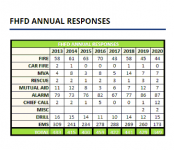You are using an out of date browser. It may not display this or other websites correctly.
You should upgrade or use an alternative browser.
You should upgrade or use an alternative browser.
FAIR HAVEN NJ 2ND ALARM 2 STORY PD 5/25/22
- Thread starter mack
- Start date

Organizational Structure
The Fair Haven Fire Company is run by an Executive Board and consists of the following five specialized organizations which work together during an emergency in a unified command structure.- Fire Department
- Emergency Medical Services
- Fire Police
- Water Rescue Unit
- Auxiliary
- Future Firefighters
- Line Officers who are responsible for all aspects of their organization’s operations, including prevention, training, and policies and procedures relating to emergency responses.
- Executive Officers who are responsible for the business and social aspects of their organization’s activities, including fund-raising, budget management, members’ benefits and well-being.
Incident Command
Each unit of the Fair Haven Fire Company uses the National Incident Managment System (NIMS), or otherwise known as the “Incident Command System.” This is where the first or highest-ranking line officer to arrive at the scene of an emergency, assumes command of the incident, including assessing the situation, creating an action plan and strategy, determining what additional resources may be needed, assuring that each member is accounted for throughout the incident, and directing the firefighting or other emergency operations. All active members of the Fire Company are trained in the Incident Command System procedures, and all members are issued personal identity cards, which they must wear during an emergency operation.The Incident Commander is automatically assigned according to the nature of the emergency. For example, if the incident is a medical emergency, the First Aid Squad Captain will assume command. If the incident is a fire or rescue, the Fire Department Chief assumes overall command of all units, including Fire, EMS, Fire Police and Auxiliary.
Since the Fire Company is all-volunteer, there may be times when the ranking line officer is not in town to assume command. Ordinarily, the next in-line officer takes command. In the rare occurrence when no active line officer is in town, a long-standing protocol is used in which the former officers with the relevant experience automatically assume Incident Command.

